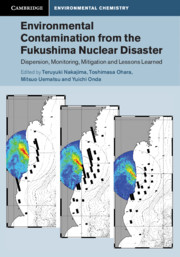 Environmental Contamination from the Fukushima Nuclear Disaster
Environmental Contamination from the Fukushima Nuclear Disaster Book contents
- Environmental Contamination from the Fukushima Nuclear Disaster
- Cambridge Environmental Chemistry Series
- Environmental Contamination from the Fukushima Nuclear Disaster
- Copyright page
- Contents
- Contributors
- Preface
- Acknowledgements
- Part I Transport of Radioactive Materials in the Environment
- Part II Development and Future Issues for the Infrastructure of Disaster Prevention
- 7 Monitoring System
- 8 Dispersion Modelling of Radioactive Materials
- 9 Off-Site Decontamination
- Part III Lessons and Future Issues from the Fukushima Accident
- Glossary
- Names of Locations
- Index
- References
9 - Off-Site Decontamination
from Part II - Development and Future Issues for the Infrastructure of Disaster Prevention
Published online by Cambridge University Press: 16 August 2019
- Environmental Contamination from the Fukushima Nuclear Disaster
- Cambridge Environmental Chemistry Series
- Environmental Contamination from the Fukushima Nuclear Disaster
- Copyright page
- Contents
- Contributors
- Preface
- Acknowledgements
- Part I Transport of Radioactive Materials in the Environment
- Part II Development and Future Issues for the Infrastructure of Disaster Prevention
- 7 Monitoring System
- 8 Dispersion Modelling of Radioactive Materials
- 9 Off-Site Decontamination
- Part III Lessons and Future Issues from the Fukushima Accident
- Glossary
- Names of Locations
- Index
- References
Summary
The Fukushima Daiichi nuclear disaster released massive amounts of radioactive substances into the environment. For isotopes with short half-lives, the primary safety concerns relate to the impacts on human health by initial exposure relatively soon after the disaster. However, isotopes with long half-lives remain in the environment for a long time; they move through the environment by many pathways and raise concerns regarding the threats to human health and everyday life. To reduce these impacts from the radioactive substances that have been dispersed widely throughout the environment, it is necessary to remove and isolate these substances from the places where people live and work, which is the purpose of decontamination. This chapter discusses the concept of decontamination, the methods used in decontamination, the institutional frameworks for decontamination and the processing and disposal of the soil and waste that is generated by decontamination.
- Type
- Chapter
- Information
- Environmental Contamination from the Fukushima Nuclear DisasterDispersion, Monitoring, Mitigation and Lessons Learned, pp. 243 - 256Publisher: Cambridge University PressPrint publication year: 2019


